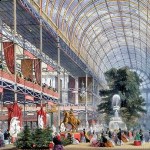The Great Exhibition
Category: 19th century The Great Exhibition of 1851, the brain child of the Prince Consort, was held in London. It demonstrated the vast wealth of the British empire created due to its industrial development. May 1st, 1851, was an exciting day for many people in Britain. The streets of London were unusually busy the morning of that day. On foot, by carriage, in crowded omnibuses, people hurried to Hyde Park for the opening day of the first world’s fair, the Great Exhibition. Soon, thousands filled the main hall of the glorious Crystal Palace, an imposing structure of 30,000 panes of glass and 5,000 iron girders specially built to house the exhibition.
The Great Exhibition of 1851, the brain child of the Prince Consort, was held in London. It demonstrated the vast wealth of the British empire created due to its industrial development. May 1st, 1851, was an exciting day for many people in Britain. The streets of London were unusually busy the morning of that day. On foot, by carriage, in crowded omnibuses, people hurried to Hyde Park for the opening day of the first world’s fair, the Great Exhibition. Soon, thousands filled the main hall of the glorious Crystal Palace, an imposing structure of 30,000 panes of glass and 5,000 iron girders specially built to house the exhibition.
At noon, Queen Victoria arrived with a flourish of trumpets. The Queen, accompanied by her husband Prince Albert, their eldest children Edward and Victoria, and the Queen’s mother, travelled the length of the hall to the platform as a thousand-voice choir sang Handel’s “Hallelujah Chorus”. Such a display was a fitting opening to a fair that would in six months attract more than six million visitors from all over the world.
The opening of the Great Exhibition was a spectacular ceremony. “The sight… was so magical — so vast, so glorious, so touching. The tremendous cheering, the joy expressed on every face, the vastness of the building… God bless… my dear country, which has shown itself so great today”, wrote Queen Victoria to her uncle in the evening of May 1st.
After watching the queen’s entrance, the opening-day visitors turned their attention to the exotic centrepieces that surrounded them. Ornamental carpets hung from the balconies, graceful palms decorated the display rooms, and a cut-glass fountain, three stories high, filled the hall with the sounds of waterfalls.
After the visitors took in that astonishing splendours, they began to view the exhibits. These included some of the world’s greatest treasures, its newest inventions, its finest manufactured products. There were fine cashmere shawls from India, laces from Belgium, beautiful pistols from Spain, and a long birchbark Indian canoe from Canada — all items most people had never seen before, not even in pictures. The USA sent a statue that, to everyone’s delight, could be spun around on its pedestal by turning a crank.
Although most of the world’s countries had exhibits, over half came from Britain, then the leading industrial nation of the world, and her Empire. British industrial machines and products showed other nations how industrialized Britain had become. Inventions such as the high-speed printing press, tool-making devices, a knife with 1851 blades, and a machine to shape railway wheels were all exhibited for the visitors to inspect.
To most of its visitors, the Great Exhibition seemed to promise an age of progress. Transportation and communication were being revolutionized. Items once considered luxuries for the rich were being made for everyone. Soon, other nations would try to match Britain’s industrial development, increasing economic growth around the world.
